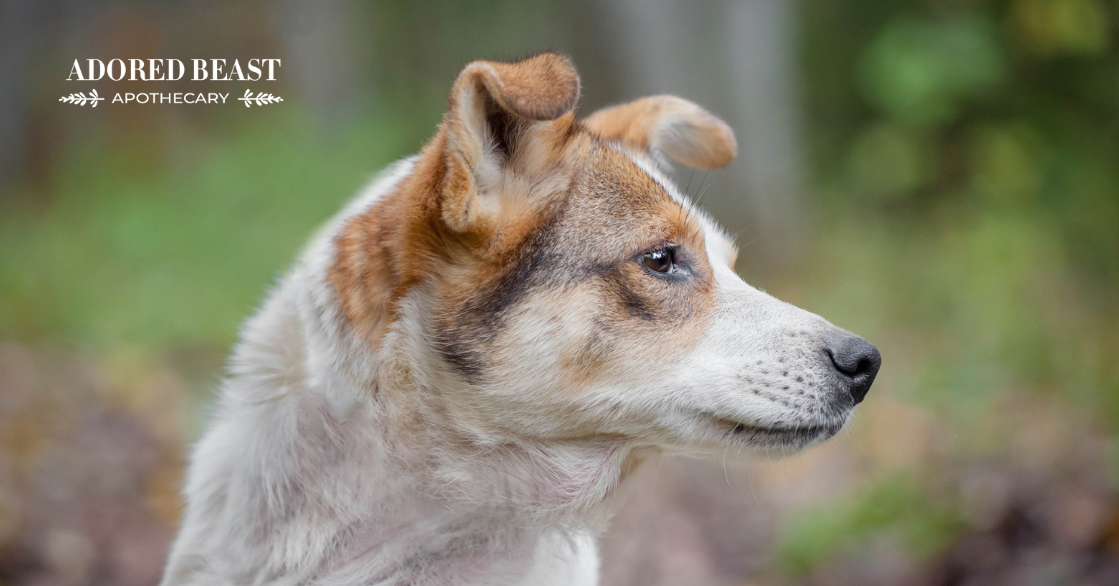Yeast. If your pet has ever dealt with it, you know that it can be uncomfortable, distressing, painful… there are lots of words to describe it, and none of them are good.
And yeast in dogs can be so tough to get rid of, especially when you’re trying not to overload the system with suppressive drugs that are not actually taking care of the issue.
So, a few months ago, Julie dove deep into the issue of yeast on one of our monthly “Ask Julie Anything” sessions. We’re sharing it here today!
What is Yeast in Dogs?
Yeast is a natural fungus that lives on your dog’s body. It doesn’t generally cause illness unless there is too much of it. Yeast needs to be part of the body’s microbiome… but too much of a good thing can turn ugly. Yeast infections can also be called malassezia dermatitis or yeast dermatitis, and it usually is most visible in a dog’s ears, between their paw pads, or in their skin folds.
There are many symptoms that are often a sure-fire sign of yeast, including:
- Itching and scratching, particularly of the toes, ears, or folds of skin
- Ear infections and head shaking
- Blackened skin
- Hair loss
- A strong smell on the skin
- Reddish fur between the toes
What causes it? Even that’s a complicated question, and there isn’t one firm answer that everyone agrees on. But, in general, it’s linked to an imbalance of the microbiome – not just of the gut, but the entire body, including the skin.
Since yeast bacteria is a natural part of your dog’s microbiome, full eradication isn’t what you want. Conventional drugs aim to do this, but when you do that, what ends up happening is you reduce the friendly bacteria’s ability to stay alert. The key with yeast in dogs is balancing the immune system. You want to keep some hooligans (bacteria) around to keep the immune system on its toes (active/fit). Getting rid of the yeast completely isn’t actually doing the body any favours.
Dos and Don’ts
There are several important dos and don’ts when it comes to dealing with yeast in dogs:
Dos:
- Go slow and steady
- Support the immune system to fight secondary bacteria caused by yeast
- Use topical herbal support that doesn’t destroy the natural bacterial defence system
- Use 100% cotton sheets – yeast thrives when there’s not a lot of air, but cotton sheets breathe, so this helps the friendly bacteria grow and helps to destroy the yeast!
Don’ts:
- Ramp it up too high or too fast by using too many pre and probiotics – this can lead to a Herx reaction (we’ll cover that below)
- Overbathe with medicated shampoos (be mindful/don’t overdo it) – that destroys ALL the bacteria, good and bad
- Use synthetic fibres – unlike breathable cotton, the dark, oxygen-depleted environment of synthetic fibres helps the yeast to grow
Herx reaction – If you kill the yeast too fast, this produces more toxins with the cell death. When yeast dies, it actually produces more toxins than when it’s alive. A Herxheimer reaction is when the symptoms actually look like they’re getting worse. It’s when the body reacts too fast and detoxes too quickly.
Going to Battle with Yeast
When it comes to effectively addressing yeast in dogs, you need to have a plan.
Step 1: The first step is reducing the yeast population with diet. You want to weaken the enemy by starving it. Candida and yeast survive on sugar, so a diet high in protein and fat (be sure you work with a veterinary nutritionist if your dog has any pancreas or liver or kidney issues!) and very low in carbohydrates (meaning zero grains and mostly green vegetables) will start to starve the cells.
Step 2: Come in full force and combat the yeast with things like specific digestive enzymes, pau d’arco, and caprylic acid. Yeast and other harmful bacteria have a coating that protects them from things like antibiotics and your immune system. This is called a biofilm – it’s literally a film that goes around the cell. Certain digestive enzymes, such as cellulase, break down that protective coating! Then the pau d’arco and caprylic acid can get to work destroying it.
- Caprylic acid comes from coconut oil. It’s used specifically to kill yeast. Give caprylic acid once per day according to your dog’s size:
- 25 mg toy
- 50mg small
- 100mg medium
- 150mg large
- Pau d’arco is a tree native to the Amazon and it works the best of any antifungal herb I’ve seen. Give pau d’arco as a dried herb, 12 mg per lb body weight, three times a day.
Step 3: The toxicity of yeast die-off can overwhelm your dog’s detoxification system, including the liver. Detoxify with liver supporting herbs and homeopathic remedies (Nux Vomica, Sulphur, Berberis, Graphites, Echinacea). You want to go gentle and slow, but help the body clear out the toxins from the dead yeast.
When Julie had her holistic veterinary clinic, so many animals came in with yeast, and that’s why she developed the Yeasty Beast Protocol. It is intended as a way to gently, safely address the yeast without overdoing it, without causing the body to overreact and go crazy (ie. a Herx reaction).
Pre and Probiotics for Yeast in Dogs?
Yeast can do major damage to the mucosal lining of the gut and destroy the microbiome of the skin. Pre- and probiotics are paramount in maintaining your dog’s defense against harmful yeast, but timing is everything! They’re also essential in helping to repopulate the friendly bacteria and rebuild and repair that mucosal lining. The same holds true for the skin. The skin needs to be rebalanced to a healthy state.
BUT! Giving probiotics too soon can cause your dog’s body to become overwhelmed by the toxins of the dead candida cells. This causes the skin to look worse and makes your dog much itchier and more uncomfortable. This is the Herx reaction we talked about above.
Therefore, pre and probiotics shouldn’t be given for at least two weeks prior to the diet change and during the addition and duration of the natural anti-fungals.
And certain probiotics are going to be more helpful than others. Saccharomyces boulardii is a type of probiotic that’s actually a yeast – sounds ironic, we know – but it stops the yeast from overcrowding! It’s a good choice.
[RELATED] Dog Gut Health: How to Improve it in 5 Simple Steps
Providing Relief
These are both great for giving your dog some relief, whether you are doing the Yeasty Beast Protocol or using some other holistic plan to help get rid of the yeast overgrowth. They will help provide some reprieve from the itching and help reduce some of the smell, all without destroying the good bacteria on the skin.
1. Love Bugs Mask
Use a ratio of 3 tablespoons of organic yogurt to 1/2 tsp of Love Bugs. Increase the amount as needed for the size of your dog. Leave it on for at least 15 minutes (30 minutes is ideal) – but only as long as it doesn’t stress your dog out. Then rinse with just water. If the yeast is bad, we recommend using it 3 times a week. For regular maintenance, once a week is good.
2. After-bath Rinse
In a litre of chamomile and green tea, add a dropper of colloidal silver, 4 sprays of Skin HEALth Spray, and 1/4 tsp of apple cider vinegar. Spray on and let it soak in – don’t rinse it off.
Cheesy, Frito feet, gunky ears, blackened bellies… and the itch, itch, itch. When yeast settles in, it can be tough to get rid of it. But there are natural ways to address it that don’t open your animal up to other issues – or just end up inviting that yeast bacteria back in. By having a plan in place, taking it slow, and doing all you can to support your animal, you can successfully battle the beast that is yeast! Good luck.












